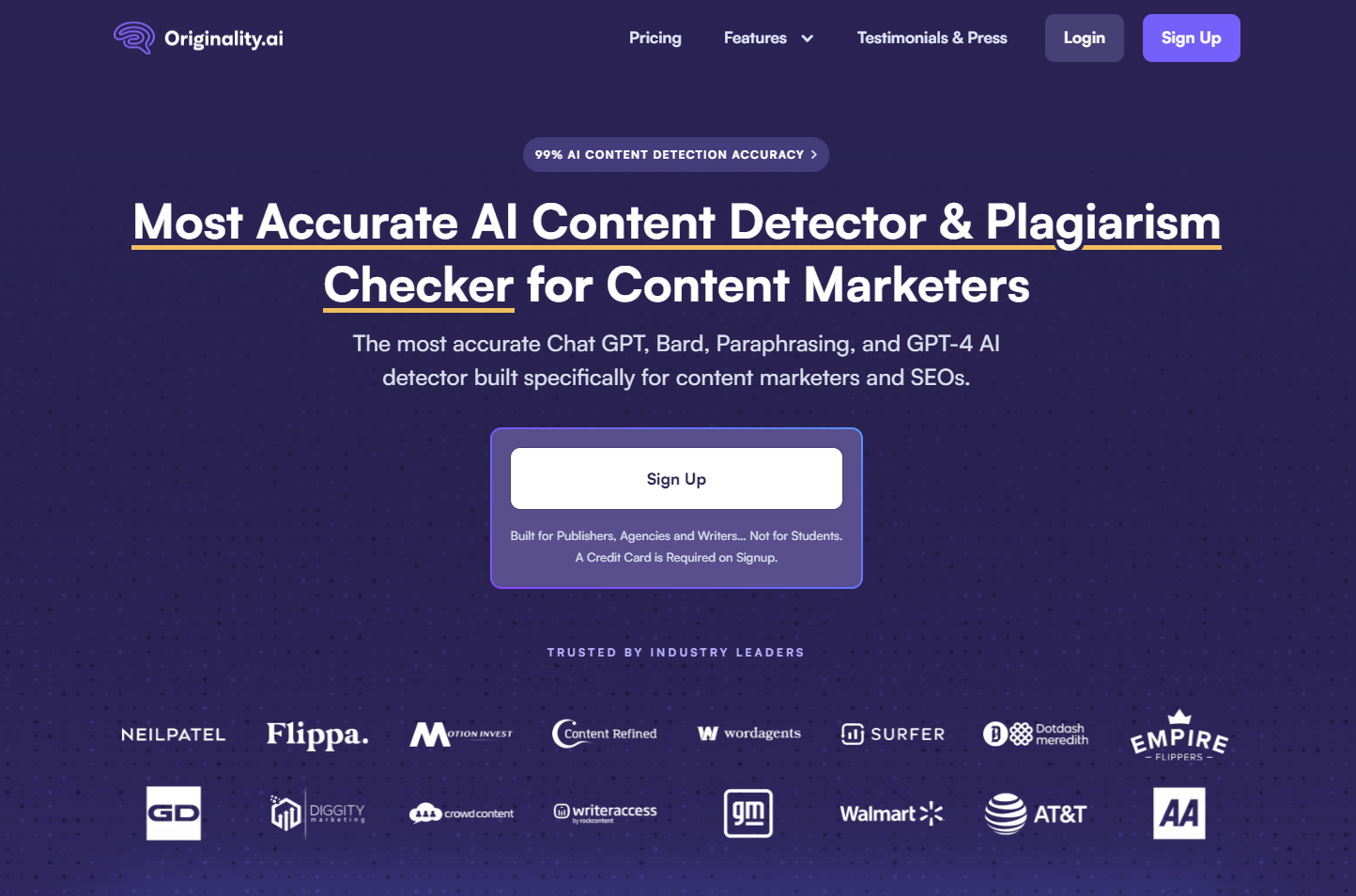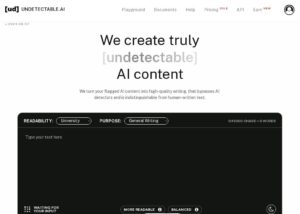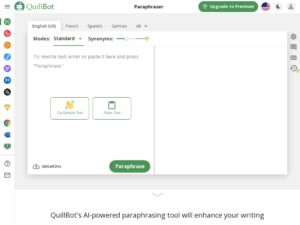Originality.ai Review 2024 | Best AI Detector & Plagiarism Checker?
In the rapidly evolving digital landscape of 2024, the distinction between content generated by artificial intelligence and that authored by humans has become increasingly blurred. Amidst this backdrop, Originality has emerged as a pioneering solution, designed to address the challenges posed by the proliferation of AI-generated text. This tool represents a significant advancement in the realm of content verification, offering a specialized focus on detecting and differentiating between text produced by AI and human creativity.
The Emergence of Originality AI in 2024
The year 2024 marks a pivotal moment in the development and integration of artificial intelligence into the fabric of content. As AI technologies have become more sophisticated, so too has the difficulty in discerning the origin of written material. Originality steps into this space with a promise to illuminate the origins of text, safeguarding the integrity of human authorship and ensuring the authenticity of written work.
Originality is not just a response to the current technological landscape but a forward-looking tool that anticipates the evolving challenges of AI-generated content. Its development is a testament to the necessity for innovative approaches to maintain the credibility and originality of content in a world where generative AI tools are increasingly accessible.
Originality: A New AI for Detecting AI-Written Content
Originality introduces a groundbreaking approach to identifying AI-written text. Leveraging advanced algorithms and machine learning techniques, it scrutinizes written content with an unparalleled depth of analysis, distinguishing subtle nuances that differentiate human from AI authorship. This capability is not merely a technical achievement but a crucial development where the integrity of authorship is paramount.
The tool operates by examining various aspects of the text, including syntax, coherence, and the patterns typical of generative AI models. This analysis allows Originality to provide users with a confidence score, indicating the likelihood that a piece of content was generated by an AI. Such insights are invaluable for educators, publishers, and creators who seek to ensure the originality and authenticity of their work in an age where AI-generated content is becoming increasingly common.
How Originality AI Works
The core functionality of Originality as an AI detector in 2024 lies in its sophisticated algorithms designed to scrutinize and differentiate between AI-generated content and human-written text. This section explores the underpinnings of Originality.ai’s detection capabilities and how it has become a pivotal tool in maintaining the originality of content across various platforms.
The AI Detection Mechanism Behind Originality
Originality leverages a state-of-the-art AI framework that scans text to identify the signature markers of AI content. By analyzing patterns, language structure, and the subtleties that typically distinguish AI-generated from human-crafted text, Originality offers a nuanced approach. The tool’s algorithm, updated for 2024, incorporates learnings from the latest AI content generators like ChatGPT, ensuring a process that is both current and comprehensive.
The process is not just about flagging AI content, but also about minimizing false positives — instances where human-written content is mistakenly identified as AI-generated. Originality.ai’s advanced scanning technology meticulously evaluates each piece of text, ensuring that the integrity of genuine human authorship is preserved while effectively identifying content that originates from AI models.
Understanding AI and Plagiarism Detection with Originality
- Plagiarism checks has been a cornerstone of academic and professional integrity.
- With the advent of AI-generated content, Originality has expanded its role of such material as a form of plagiarism.
- This is particularly relevant as the lines between AI-assisted and purely human-produced content blur.
- Originality.ai’s plagiarism checker feature goes beyond traditional similarity scans.
- It specifically looks for the nuances that suggest a piece of content might have been generated by AI, such as the overuse of certain phrases typical to AI models or an unnatural consistency in writing style.
- This capability is crucial for academic institutions and publications that are adapting to the challenges.
Originality AI Review: An Honest Assessment
An honest review in 2024 reveals a tool that is indispensable for creators, educators, and anyone concerned with the authenticity of written work. This section provides an insight into the user experience, highlighting the tool’s efficacy in detecting AI-generated content and its impact on users.
Originality distinguishes itself not only through its capabilities to detect but also through its user-friendly interface. Designed with the user in mind, the platform allows for straightforward navigation, making it accessible for users with varying levels of technical expertise. Whether for a quick scan or a detailed analysis, users can easily submit their text for review, with the system providing clear, actionable feedback on the detected level of AI involvement in the content.
This ease of use extends to integrating Originality into existing workflows. Content creators, from writers to academic researchers, can seamlessly incorporate Originality.ai scans into their creation process, ensuring the originality and authenticity of their work without disrupting their established routines.
Originality in Action: Use Cases and Workflow
Practical applications of Originality showcase its versatility and effectiveness as both an AI detector and plagiarism checker. This section examines how Originality.ai seamlessly integrates, enhancing the detection of AI-generated content and maintaining the integrity of original work.
Enhancing Workflow with Originality.ai: A Freelance Writer’s Perspective
Freelance writers, often at the forefront of adopting the best AI writing tools, have found Originality to be an indispensable asset. It’s not merely about ensuring their work isn’t inadvertently flagged as AI-generated by publishers but also about maintaining a high originality score that reflects their creative integrity. Originality’s review process offers a dual advantage: it screens for potential plagiarism and verifies the content hasn’t been AI generated, providing peace of mind for both the writer and the client.
The AI content capabilities of Originality.ai enable writers to preemptively address sections of their work that could be flagged as AI. This foresight allows them to refine their submissions, ensuring that their voice remains distinct and their content authentically human.
Using Originality.ai for Academic Integrity: Plagiarism Checker
In academic settings, the distinction between AI-assisted research and outright plagiarism has become a gray area, with Originality serving as a critical tool for educators and students alike. The platform’s AI detection tool is particularly adept at identifying content that, while not plagiarized in the traditional sense, has been generated by AI, thus upholding the standards of academic originality and integrity.
Originality.ai’s nuanced approach to detecting AI-written content provides an additional layer of scrutiny in academic work, ensuring that students learn to engage with AI tools ethically and responsibly. By incorporating Originality into their review process, educational institutions can safeguard against the indiscriminate use of AI in academic writing, promoting a culture of genuine learning and originality.
Comparing Originality with Other Tools
With a plethora of AI content detectors on the market, how does Originality stand out? This section offers a comparative analysis, highlighting what sets Originality.ai apart as the best AI detection tool in 2024.
Tools Like Originality.ai: A Comparative Analysis
When compared to other AI detectors and plagiarism checkers, Originality distinguishes itself through its specialized focus on distinguishing AI-generated content from human-written text. While many tools can flag instances of potential plagiarism, Originality.ai excels in its ability to discern the nuances. This specificity is crucial in a landscape where AI-generated content is becoming more sophisticated. The algorithms are constantly updated to keep pace with the latest developments in AI writing technologies, ensuring that its detection capabilities remain at the forefront of the industry.
Originality vs. Traditional Plagiarism Detection Software
The comparison between Originality and traditional plagiarism detection software underscores a fundamental shift in how originality defined and detected in the digital age. Unlike standard plagiarism checkers that focus on matching text to existing sources, the review process delves into the characteristics of the text itself.
This approach reflects a nuanced understanding of the challenges posed by AI in article creation, highlighting unique position as a tool adept at navigating the complexities of AI-generated content. Its capacity to not only detect but also provide a detailed originality score further establishes its utility in ensuring content authenticity.
Practical Experience with Originality
Sharing a personal account of utilizing Originality offers insights into its real-world application, particularly its effectiveness in detecting AI content and ensuring the originality of written material. This section reflects on the ease of use and the reliability of Originality as an AI detection tool.
My Recent Experience with Originality: A Freelance Writer’s Perspective
As a writer, I’ve recently explored various tools capable of detecting AI-generated content, with a special focus on Originality. With its free trial, I had the opportunity to test the platform on several pieces I personally wrote, alongside content I knew was crafted by generative AI. The AI detection score provided by Originality was impressively accurate, flagging content as AI-generated with a precision that underscored its advanced algorithms.
Even though AI has become an integral part of article creation, distinguishing content written by human from that generated by AI remains crucial for maintaining authenticity. Originality stood out, allowing me to seamlessly integrate it. The tool not only detected AI paraphrasing with remarkable accuracy but also reassured me of the originality of my own work, which was consistently marked as written by a human.
Evaluating the Cost-Effectiveness of Originality
- When considering the cost of using AI detection tools, Originality presents an appealing proposition. Priced at just $0.01 per check, it offers an affordable solution for writers and creators looking to verify the originality of their work without breaking the bank. This pricing model, combined with the tool’s robust detection capabilities, represents a valuable investment in the quality and integrity of one’s content.
- The free trial provided by Originality is a thoughtful touch, allowing users to gauge the tool’s effectiveness before committing financially. For creators wary of inadvertently using AI-generated content or those keen on ensuring their work remains uniquely theirs, Originality’s service is both accessible and essential.
Originality: A Must-Have for Content Creators and AI Writers
In an era dominated by generative AI, tools like Originality have become indispensable for creators and AI writers alike. The platform’s capability of detecting AI content with a high degree of accuracy ensures that creators can confidently claim the originality of their work. For those who have used AI to assist in content creation, Originality AI offers a reliable way to check the originality and mitigate any potential issues with AI-generated segments being too prominent.
Originality stands out not just as a plagiarism detector but as a comprehensive content detection tool. It caters to the nuanced needs of modern content creation, where the lines between AI-assisted and purely original work are increasingly blurred. For anyone in the content creation sphere, from writers to academic researchers, Originality offers the peace of mind that their work is genuinely their own, even in the face of ever-advancing AI technologies.
A Critical Look at Originality: Questioning Effectiveness and Intent
The journey with Originality takes a turn as we encounter experiences that challenge the tool’s credibility and its overall value to the user. This part of the review presents a more critical perspective, reflecting on the concerns and disappointments faced by some users.
Dissecting a Disappointing Experience with Originality
I recently encountered a situation that has led me to question the reliability and intentions behind Originality. After deciding to test the tool’s plagiarism checking capabilities, I submitted an article that was previously published on a reputable health website, currently ranked third on Google. Despite my confidence in the article’s originality and its success online, Originality flagged significant portions of my work as potentially AI-generated.
This perplexing outcome has led me to believe that the entire system might not be as reliable as advertised. The fact that earlier work, which was both successful and original, could be flagged in such a manner, is concerning. It suggests a potential flaw in the detection algorithm or, more troublingly, a system designed more to profit the sponsors while possibly deceiving customers about its efficacy.
The Issue of False Positives and System Trustworthiness
The incident of my article being unjustly flagged raises significant questions about the occurrence of false positives in the detection process. Such inaccuracies can tarnish the reputation of content creators and cast doubt on the authenticity of genuinely original work. It leads to a critical analysis of whether Originality, and tools like it, are truly capable of distinguishing between AI-generated and human-written content with the precision they claim.
Furthermore, this experience, coupled with the concerns about the tool’s business model—purportedly designed to profit the sponsors while potentially misleading users—casts a shadow over the trustworthiness of the system. If a tool only works in a way that serves its financial backers, can it genuinely serve the best interest of its users?
Reflecting on the Need for Transparency and Accuracy
This recent, extremely dissatisfying experience with Originality AI has highlighted the necessity for greater transparency and accuracy in content detection tools. Users rely on these platforms to provide a fair assessment of their work’s originality, especially in professional settings where credibility is paramount. When a tool could mistakenly give a zero-star rating to previously acclaimed work, it underscores the need for a reevaluation of the criteria and algorithms such tools use.
Moreover, the provision of free credits by Originality.ai offers a glimpse into its potential but also sets up expectations for its performance. When these expectations are not met, especially in cases where the tool’s accuracy is in question, it prompts users to seek alternatives that can more reliably meet their needs for originality verification and plagiarism detection.
The journey with Originality AI—from its promising introduction as a leading AI detector and plagiarism checker to facing scrutiny over its effectiveness and business practices—illustrates the complexities of navigating the burgeoning field of AI content detection. While Originality AI offers a new avenue for ensuring the authenticity of content in an age dominated by AI, experiences of dissatisfaction and concerns about the system’s integrity call for a careful consideration of how such tools are employed and developed.
For content creators, the quest for a reliable AI content detection tool continues, underscored by a desire for accuracy, fairness, and transparency in the fight against AI-generated plagiarism and the preservation of originality in digital content creation.
References & Further Reading
ZeroGPT. “ZeroGPT: Your Go-To Platform for AI Content Detection.” Retrieved from ZeroGPT.net.
Winston AI. “Winston AI: Advanced AI Content Detection.” Retrieved from gowinston.ai.
Crossplag. “Crossplag: Plagiarism Detection and AI Content Analysis.” Retrieved from crossplag.com.
GLTR. “GLTR: Giant Language Model Test Room by MIT-IBM Watson AI Lab and HarvardNLP.” Retrieved from gltr.io.
Content at Scale. “Content at Scale: Detecting AI-Generated Content with Precision.” Retrieved from contentatscale.ai.
Originality.ai. “Originality.ai: AI Detection and Plagiarism Checker Combined.” Retrieved from originality.ai.
Undetectable.ai. “Undetectable.ai: Making AI-Generated Content Human.” Retrieved from undetectable.ai.





